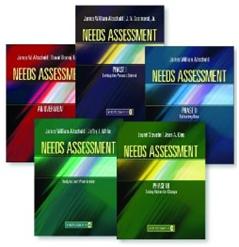I’m James Altschuld, Professor Emeritus of Ohio State University. So you have to conduct a needs assessment! You are an evaluator in an organization or expert consultant, you know what to do. You have a sense of what needs assessment is but you really haven’t been involved in one before and now you are concerned.
Lessons Learned: Use the 3 Phase Model
One framework that could guide you (from a biased perspective) is the 3 Phase Model in books that I coauthored,
Planning and Conducting Needs Assessments (1995) and in 2010’s Needs Assessment Toolkit: An Overview (Book 1), described below.
Phase 1 – Pre-Assessment. Form a guiding committee to work on the assessment. It defines concerns, finds existing information on the ‘what should be’ and ‘what is’ conditions of needs, and specifies discrepancies between them.
- Keep the committee small for efficiency.
- Select knowledgeable members with the time to locate relevant reports, articles, past studies/needs assessments, etc.
- Look for available sources rather than creating data.
- Examine what was found and decide that the needs are not important enough to do anything more, we should explore them in greater depth (Phase 2), or there is enough understanding to move to solutions (Phase 3).
Hot Tip – This is the least costly part of needs assessment because new data is not sought.
Phase 2 – Assessment. The committee requires more information via surveys, interviews, observations, epidemiology, data base exploration; once collected and analyzed there is a better idea of needs – size, causes, which might be of highest priority, and even potential solution strategies for the most important ones.
- Employ qualitative and quantitative methods for greatest understanding.
- Scan the literature for methods, instruments, and possible questions.
- Obtain data from service recipients, service providers, and administrators.
Hot Tips – Collecting, analyzing, and reporting new information are costly. Consider smaller samples and cheaper ways to do it.
Phase 3 – Post Assessment. From the findings in Phases 1 and 2, the committee selects strategies for resolving needs and helps the organization plan and evaluate them.
- Find out what other organizations have done with similar problems.
- Break solutions into smaller parts for implementation, if possible.
- Needs assessors should stay involved with organization for a good portion of Phase 3
- Evaluating the needs assessment process and solution strategies is in all 3 Phases.
Hot Tip – Solutions flow from the causes of needs.
Hot Tip – Join the Needs Assessment Topical Interest Group leadership at our Business Meeting during the AEA Annual Conference in October to get more involved in the TIG!
The American Evaluation Association is celebrating Needs Assessment (NA) TIG Week with our colleagues in the NA AEA Topical Interest Group. The contributions all this week to aea365 come from our NA TIG members. Do you have questions, concerns, kudos, or content to extend this aea365 contribution? Please add them in the comments section for this post on the aea365 webpage so that we may enrich our community of practice. Would you like to submit an aea365 Tip? Please send a note of interest to aea365@eval.org. aea365 is sponsored by the American Evaluation Association and provides a Tip-a-Day by and for evaluators.

Pingback: NA TIG Week: Hsin-Ling (Sonya) Hung on Needs Assessment and Decision-making · AEA365